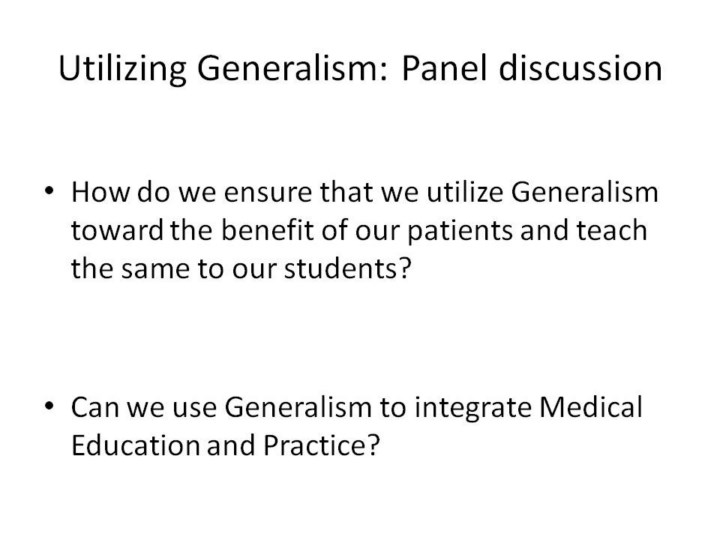| front |1 |2 |3 |4 |5 |6 |7 |8 |9 |10 |11 |12 |13 |14 |15 |16 |17 |18 |19 |20 |21 |22 |23 |24 |25 |26 |27 |28 |29 |30 |31 |32 |33 |34 |35|36 |37 |38 |39 |40 |41 |42 |43 |44 |45 |46 |47 |48 |49 |50 |51 |52 |53 |54 |55 |56 |57|58 |59 |60 |61 |62|63 |64 |review |
 |
These are questions that may be discussed in the panel discussion that follows this deliberation. Frome what has already been discussed here is a summary:
We can begin to develop an optimal model that addresses both demands for specifism as well as generalism (also raised in slide 32 and 33 of the what-why presentation shared earlier with the 3 presentation modules on what-why, how and assessment of competency).
This model can be first trialed in our academic institutes and this is the reason we need to organize all MBBS teachers into becoming generalists, make all of them see 'whole' patients (other than continuing with their specialized roles in biochemistry, physiology, anatomy, pharmacology, pathology) and also make current clinician-academics spend time in the laboratory with their (so-called) pre and para-clinical academic colleagues.
Let me illustrate with a best case scenario as to how this 'optimization' of generalism and specifism may be achieved in most medical college settings:
Ms X is a 10+2 student who has just cracked the JEE and has entered medical college where the very first day is spent with a patient and a group of other students and few faculty discussing the patient's problem.
This student has had to go through an extensive interviewing before getting into Medical school to check if s/he has the optimal kind of aptitude to balance generalism and specifism (the kind that actually happens for most Australian students even now...see sample interview questions for a pre-med interview here: http://multipleminiinterview.com/mmi-questions/).
Ms X on her first day notices that most of her batch-mates and faculty around the patient are asking questions and no one is pressurizing them or shaming the students (or each other) if they do not know the answer. They are on the other hand being encouraged to find out by visiting the library or even from their high speed computers.
In this manner Ms X learns the entire spectrum of patients (and all relevant patient centered anatomy, physiology, pathology etc) that can be expected from an Indian MD general medicine in just two years of her MBBS course and what's more s/he is able to even think of exciting research projects from the ideas generated from many of her patients. Most of the faculty are generalists who also are specialized in physiology, anatomy, pathology, gastroenterology, surgery and who also have specific projects related to their areas as well as projects that overlap between all areas.
After the end of 4 years Ms X opts for becoming a life-long generalist as s/he is interested in becoming a faculty member and many of her friends who are not interested in becoming faculty opt for residencies where they just need to focus on one organ and then can practice in community settings and become fee-for-service practitioners or full-time specifist-focused researchers without any generalist commitments. Ms X on the other hand goes on to embrace a career in life-long discovery based learning that also enables her to contribute newer innovative solutions with a multidisciplinary team in her college (which also includes computer scientists and other engineers).
|